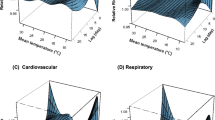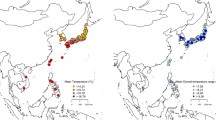Abstract
After considering the observed long-term trends in average monthly temperatures distribution in Moscow, the authors evaluated how acute mortality responded to changes in daily average, minimum and maximum temperatures throughout the year, and identified vulnerable population groups, by age and causes of death. A plot of the basic mortality–temperature relationship indicated that this relationship was V-shaped with the minimum around 18°C. Each 1°C increment of average daily temperature above 18°C resulted in an increase in deaths from all non-accidental causes by 2.8%, from coronary heart disease by 2.7%, from cerebrovascular diseases by 4.7%, and from respiratory diseases by 8.7%, with a lag of 0 or 1 day. Each 1°C drop of average daily temperature from +18°C to −10°C resulted in an increase in deaths from all non-accidental causes by 0.49%, from coronary heart disease by 0.57%, from cerebrovascular diseases by 0.78%, and from respiratory diseases by 1.5%, with lags of maximum association varying from 3 days for non-accidental mortality to 6 days for cerebrovascular mortality. In the age group 75+ years, corresponding risks were consistently higher by 13–30%. The authors also estimated the increase in non-accidental deaths against the variation of daily temperatures. For each 1°C increase of variation of temperature throughout the day, mortality increased by 0.3–1.9%, depending on other assumptions of the model.



Similar content being viewed by others
References
Danet S, Richard F, Montaye M, Beauchant S, Lemaire B, Graux C, Cottel D, Marécaux N, Amouyel P (1999) Unhealthy effects of atmospheric temperature and pressure on occurrence of myocardial infarction and coronary deaths. A 10-year survey: The Lille-WHO MONICA Project. Circulation 100:e1–e7
Donaldson GC, Tchernavski VE, Ermakov SP, Bucher K, Keatinge WR (1998) Winter mortality and cold stress in Ekaterinburg, Russia: interview study. Br Med J 316:514–518
Hajat S, Kovats RS, Atkinson RW, Haines A (2002) Impact of hot temperatures on death in London: a time series approach. J Epidemiol Community Health 56:367–372
Hajat S, Armstrong BG, Gouveia N, Wilkinson P (2005) Mortality displacement of heat-related deaths. A comparison of Delhi, Sao Paulo, and London. Epidemiology 16(5):613–620
Heady JD (2003) Excess winter mortality in Europe: a cross-country analysis identifying key risk factor. J Epidemiol Community Health 57:784–789
Huynen M, Martens P, Schram D, Weijenberg MP, Kunst AE (2001) The impact of heat waves and cold spells on mortality rates in the Dutch population. Environ Health Perspect 109(5):463–465
Isaev (2003) Chronicle of weather, climate and ecology of Moscow. Hydrometeoizdat, St. Petersburg
Keatinge WR, Donaldson GC (2001) Mortality related to cold and air pollution in London after allowance for effects of associated weather patterns. Environ Res Sect A 86:209–216
McKee M, Sanderson C, Chenet L, Vassin S, Shkolnikov V (1998) Seasonal variation in mortality in Moscow. J Public Health Med 20:268–274
Michelocci P, Fano V, Forastiere F, Barca A, Kalkstein L, Perucci C (2000) Weather conditions and elderly mortality in Rome during summer. Bull World Met Org 49:348-355
Morabito M, Modesti P, Cecchi L, Crisci A, Orlandini S, Maracchi G, Gensini G (2005) Relationships between weather and myocardial infarction: a biometrical approach. Int J Cardiol 105:288–293
Revich B, Shaposhnikov D (2006) Climate, air quality and mortality in Moscow in 2000–2006. In: Revich B (ed) Climate, air quality and public health in Moscow. Institute of Economic Forecasting, Moscow, pp 102–140
The Eurowinter Group, Coordinating team – WR Keatinge, GC Donaldson (1997) Cold exposure and winter mortality from ischaemic heart disease, cerebrovascular disease, and all causes in warm and cold regions of Europe. Lancet 349:1341–1346
Acknowledgements
Research for this article was supported by NGO Environmental Defense (USA). The authors thank Dr. A. Golub and Dr. E. Strukova from Environmental Defense for guidance, advice and comments. Mortality data were obtained from Dr. T. Khorkova from Institute of Demography. Meteorology data were provided by Prof. A. Isaev and his colleagues from Moscow State University weather station.
Author information
Authors and Affiliations
Corresponding author
Rights and permissions
About this article
Cite this article
Revich, B., Shaposhnikov, D. Temperature-induced excess mortality in Moscow, Russia. Int J Biometeorol 52, 367–374 (2008). https://doi.org/10.1007/s00484-007-0131-6
Received:
Revised:
Accepted:
Published:
Issue Date:
DOI: https://doi.org/10.1007/s00484-007-0131-6




